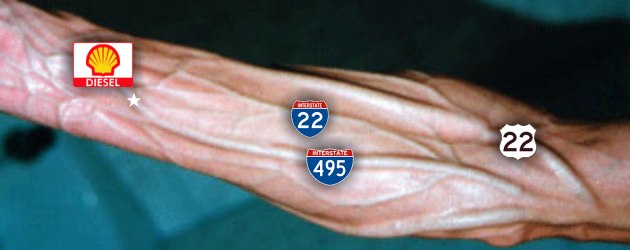In the world of biometrics, what can be more complicated and trustworthy than fingerprinting, face and iris recognition? Fingerprinting can be “lifted” and obviously it is very easy to capture an image of someone’s face or iris covertly. Voice can also be easily recorded. So what’s left? DNA? Sure… get out the needle or swab… : – ) The Japanese it would seem are adamant that vein identification is the next big thing. Some of its benefits include the vein patterns in each person being very unique and certain scanners providing the ability to collect the vein print in a contactless fashion (no finger to put down on a dirty platen).
 This biometrics technology typically scans the blood vessels by passing near-ultraviolet light through the finger (fancy term of the week: “Transillumination”), and obtains a 3-D profile of the vein pattern. Like fingerprints no two persons are said to have the same vein pattern. This information can then be stored as an image, but more likely as a feature vector (a digital code representation of a much larger image).
This biometrics technology typically scans the blood vessels by passing near-ultraviolet light through the finger (fancy term of the week: “Transillumination”), and obtains a 3-D profile of the vein pattern. Like fingerprints no two persons are said to have the same vein pattern. This information can then be stored as an image, but more likely as a feature vector (a digital code representation of a much larger image).
Since fingers are not readily exposed veins cannot be easily forged by covert lifting or manipulated without the owner’s permission (obviously!). Even in the most imaginative situation of dismemberment of the finger, it is claimed that identification will not be possible due to loss of blood pressure to the finger.
Some vendors even claim that finger vein identification has less false rejection than fingerprinting and the numbers they are throwing around include a false rejection rate of no more than 0.01% and false acceptance rate of less than 0.00002%. Due to the simpler nature of the optics required in such a device, it can also be significantly less expensive and easy to install than iris scanning devices, high-end face cameras or expensive fingerprint scanners (the optical multi-finger ones can be $$$pricey$$$!!). After being widely used in Japan at thousands of ATMs and cash machines, European companies have also started adopting this technology. Its use has also been spreading all other application scenarios like door access systems, PC log-on systems, mobile handsets and even, in car ignition systems. This is due to the fact that the system is compact enough to fit in almost any devices.
